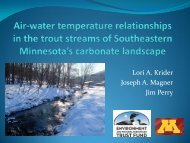Minnesota Water Resources Conference - Water Resources Center ...
Minnesota Water Resources Conference - Water Resources Center ...
Minnesota Water Resources Conference - Water Resources Center ...
You also want an ePaper? Increase the reach of your titles
YUMPU automatically turns print PDFs into web optimized ePapers that Google loves.
Concurrent Sessions VI 3:00–4:30<br />
Track C: Urban Pollutants: Source, Transport and Treatment<br />
BOOK OF ABSTRACTS<br />
Wednesday, Tuesday, October 24 28 23<br />
Land Cover and Impervious Classifications of the Minneapolis/St. Paul Metropolitan Statistical Area<br />
Marvin Bauer, University of <strong>Minnesota</strong>, mbauer@umn.edu<br />
Land cover and land use are critical drivers of environmental change and improved information and<br />
understanding of their spatial and temporal dynamics is essential for effective land and water management and<br />
policy. Over large geographic areas satellite remote sensing represents the most effective means to map and<br />
monitor land cover. Impervious surface area is a key component of land cover-use and an important indicator<br />
of environmental quality, affecting stormwater runoff to streams and lakes and water quality of surrounding<br />
lakes and streams.<br />
This presentation will describe the results of classifications of multispectral Landsat data acquired in 2007 of the<br />
Minneapolis−St. Paul Metropolitan Statistical Area and the St. Croix River Basin of <strong>Minnesota</strong> and Wisconsin.<br />
The data will provide new, current maps and information quantifying the spatial patterns of land cover and<br />
impervious area of this region that can used as inputs to hydrology, stormwater and water quality models.<br />
Inventory and Hydrologic Transport of Road Salt in the Twin Cities Metropolitan Area<br />
Eric Novotny, University of <strong>Minnesota</strong>, nov00002@umn.edu; Andrew Sander, University of <strong>Minnesota</strong>; Omid Mohseni,<br />
University of <strong>Minnesota</strong>; Heinz Stefan, University of <strong>Minnesota</strong><br />
Over 330,000 tons of road salts (NaCl) are applied annually for road de-icing in the Twin Cities Metropolitan<br />
Area (TCMA). Observed salinity exceeds standards in a few streams and lakes seasonally. The hydrologic<br />
transport of salt, including road salt and water softener salt, through the TCMA watershed was analyzed.<br />
A hydrologic salt budget for TCMA watersheds was constructed using salinity data from major rivers, salt<br />
application rates, and wastewater treatment plant effluents. A residual of the amount of salt imported and used<br />
in the TCMA but not carried away by the Mississippi River was determined. Potential retention in soils, lakes<br />
and wetlands, and ground water is being investigated. Physical and chemical effects of saline water runoff into<br />
urban lakes were investigated, including (1) formation of a saline layer at the lake bottom, (2) long-term salinity<br />
increases in surface waters (3) seasonal salinity patterns and (4) penetration of salt into lake sediments. Field<br />
measurements and historical data were interpreted. Results will be reported.<br />
Assessing Hydrodynamic Separators under High <strong>Water</strong> Flow Conditions<br />
David Saddoris, University of <strong>Minnesota</strong>, saddo002@umn.edu; Omid Mohseni, University of <strong>Minnesota</strong>; and John Gulliver,<br />
University of <strong>Minnesota</strong><br />
Underground hydrodynamic separators are widely used in urban areas for removal of suspended solids and<br />
floatables from stormwater due to limited land availability for the installation of above ground stormwater<br />
BMPs. Hydrodynamic separators are sized for applications based on design stormwater flow rates. However,<br />
during less frequent storm events, design flow rates are exceeded and previously captured sediments can<br />
be scoured and washed out of these devices. A new methodology will be introduced to assess the scouring<br />
potential of these devices under flow rates exceeding their maximum treatment rates. The test method involves<br />
pre-loading the devices with sediments of known particle sizes, flowing water at flow rates above maximum<br />
treatment rates, and measuring the amount of sediments remaining inside the devices. The results of controlled<br />
field testing and laboratory testing on three commercial devices using this methodology will be presented, and<br />
implications of the findings on design and maintenance will be discussed.<br />
<strong>Minnesota</strong> <strong>Water</strong> <strong>Resources</strong> <strong>Conference</strong>, October 27–28, 2008 80
















